Affiliate disclosure: This post may contain affiliate links. Please see our Privacy Policy.
Mango wine has a reputation for capturing the very essence of mango in a light and sweet summer wine. I’ll ferment just about anything that’ll fit in a carboy, but somehow I’ve never gotten around to making it.
After 10 years of home brewing, adding yeast to anything with even a hint of promise, we always make our first batches small. I’ve made a few too many toxic 5-gallon batches to waste ingredients before I have a winning recipe. Single bottle quart batches are a great way to refine a recipe before investing a lot of money in homemade wine.
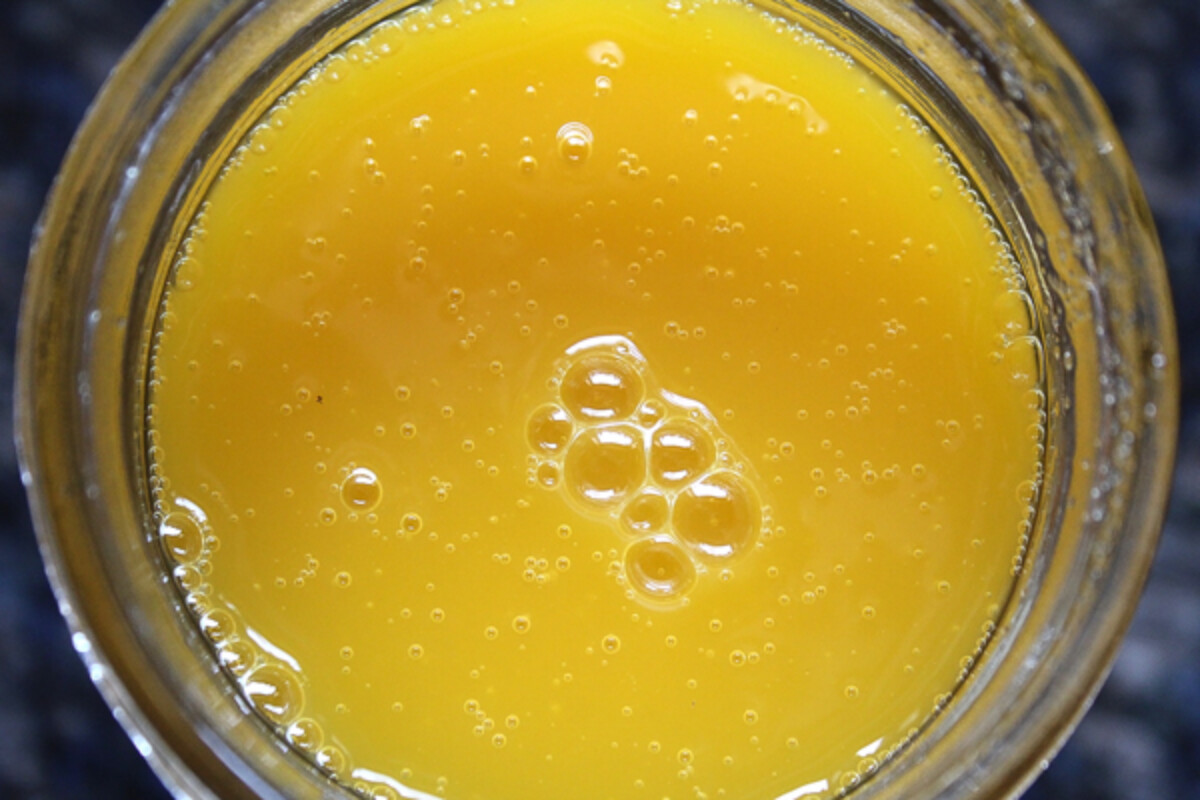
How to Make Mango Wine
Most mango wine recipes start with fresh whole mangoes. The problem is, it’s tricky to get the juice out of mangoes. Even with a really sexy expensive juicer, at best you get mango pulp. When starting with fresh mangoes, a brewing additive known as pectinase or pectic enzyme is used to break up the pectin in the fruit cells and release the juice.
Up here in Vermont, mangoes aren’t exactly cheap either. A friend of mine at the Smiley Farm in Northern California starts his batches with 20 pounds of fresh mangoes. Around here that’d set us back at least $100.
If you do have access to cheap mangoes and a ready to try a big batch from a proven recipe, he shares his recipe in this discussion thread. He uses a number of enzymes and additives to get the wine crystal clear and perfectly sweet, including:
- Pectic Enzyme for breaking open the mango fruit cells.
- An acid blend to decrease the overall pH.
- Yeast Nutrient to feed the little beasties and give them the micronutrients that help them thrive.
- Tannin to give the sweet wine a bit of astringency and balance the flavor.
- Potassium Sorbate and Camden tablets (potassium metabisulfite) to completely end the fermentation and stabilize the wine before bottling.
For my very first batch, I’m keeping things really simple and try to make my mango wine with ingredients I have in my home pantry.
I’m going to use mango juice instead of mango chunks with the hopes that I won’t need pectic enzyme. Instead of a prepared acid blend, I’m going to try simple lemon juice, and I’ll use black currant and grape leaves for the tannin. I’m ok with my wine finishing with a bit of carbonation in the bottle, so I’m skipping the stabilizers.
In the recipe below, I’ll give you instructions for making a standard mango wine with all the additives in the right proportion, so you can either make mango wine with standard wine-making ingredients, or you can try a kitchen pantry version.
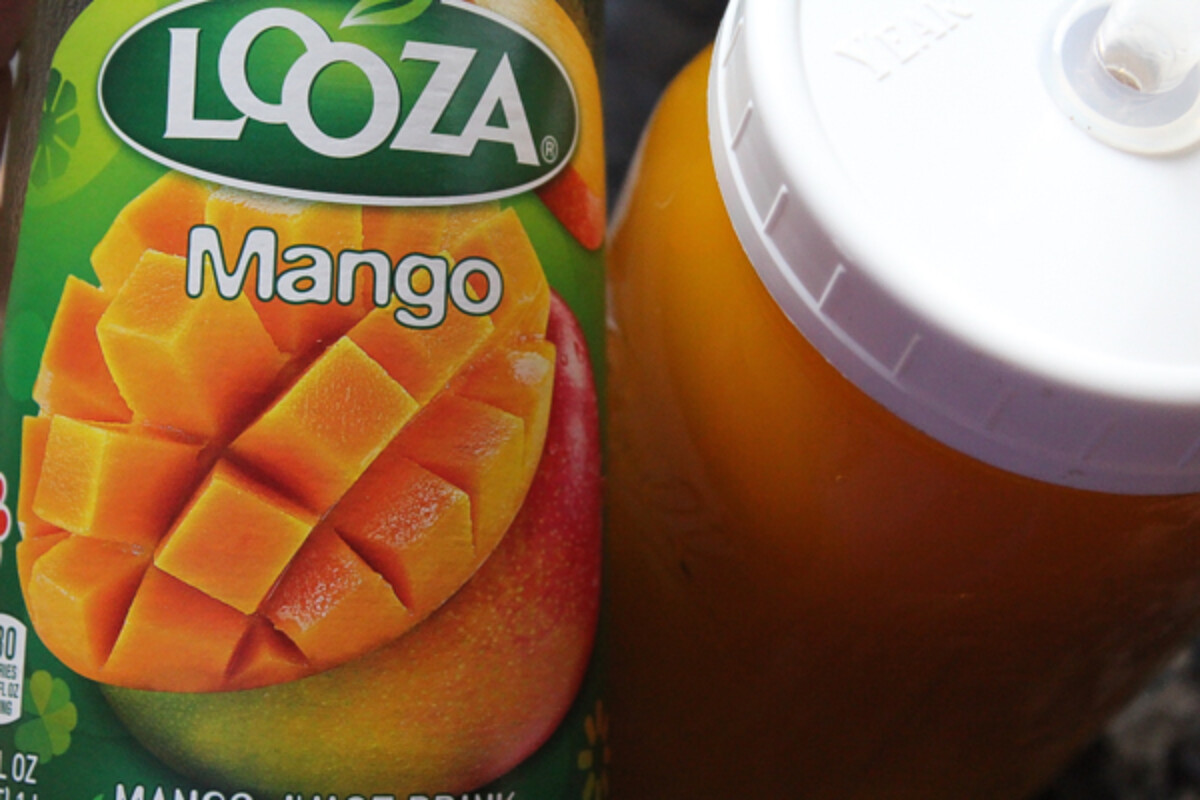
Our local market sells a brand of mango juice (bottled in Belgium of all places) that is just mango juice, water and sugar. No preservatives and no additives. I’m using that as a base. If stores near you don’t have it, it’s available here.
It’s a very smooth juice, and hopefully, I’ll be able to make a wine without added pectic enzyme. We’ll see.
Since this is a test batch, I’m making this batch in a quart mason jar using a mason jar fermentation kit. It’s a simple lid that turns any wide mouth mason jar into a fermentation vessel for anything from sauerkraut and natural pickles to homemade meads, wines and beer. I’ve made many small-batch meads using this method.
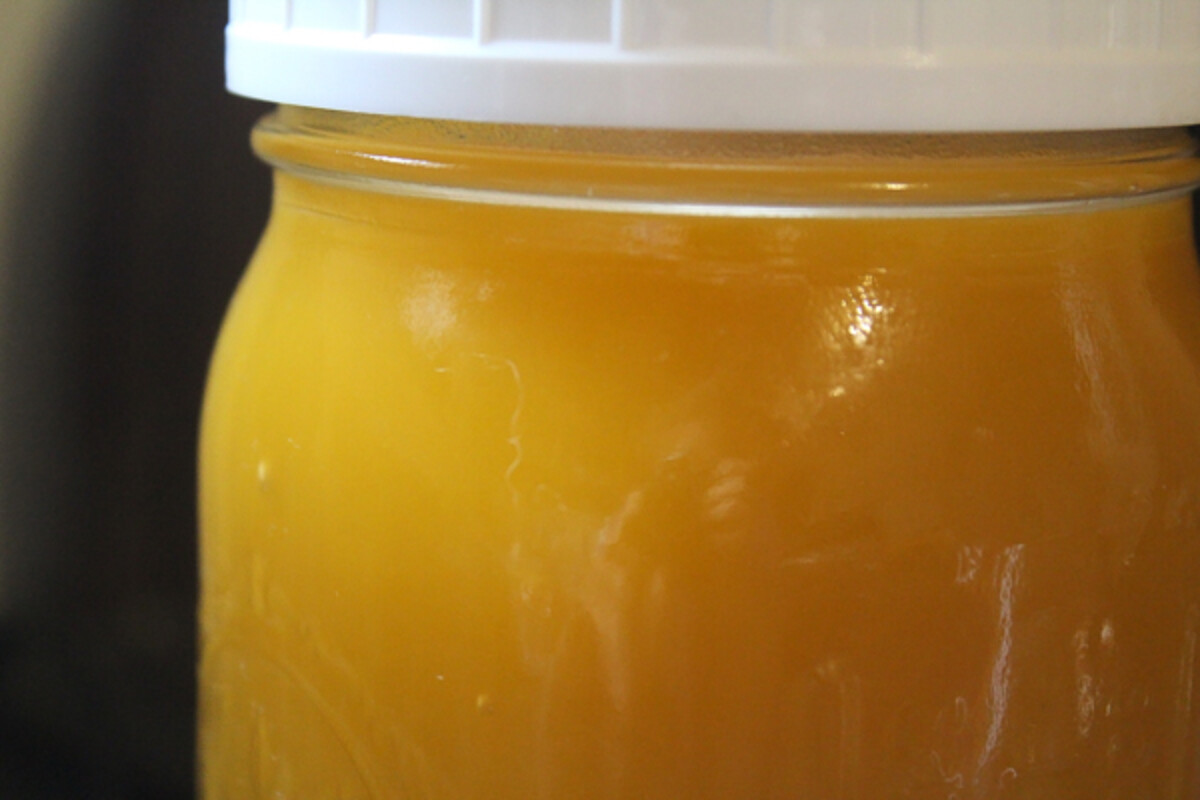
For super tiny 1 quart batches, it’s best to just bottle in a simple Grolsch bottle and save the effort of getting out the wine bottles and corks. To bottle, all you need is a small funnel and a careful pouring hand.
Start by carefully pouring the mango wine off into a second container, being careful not to disturb the sediment at the bottom. Next, pour the finished mango wine into a bottle using a small funnel.
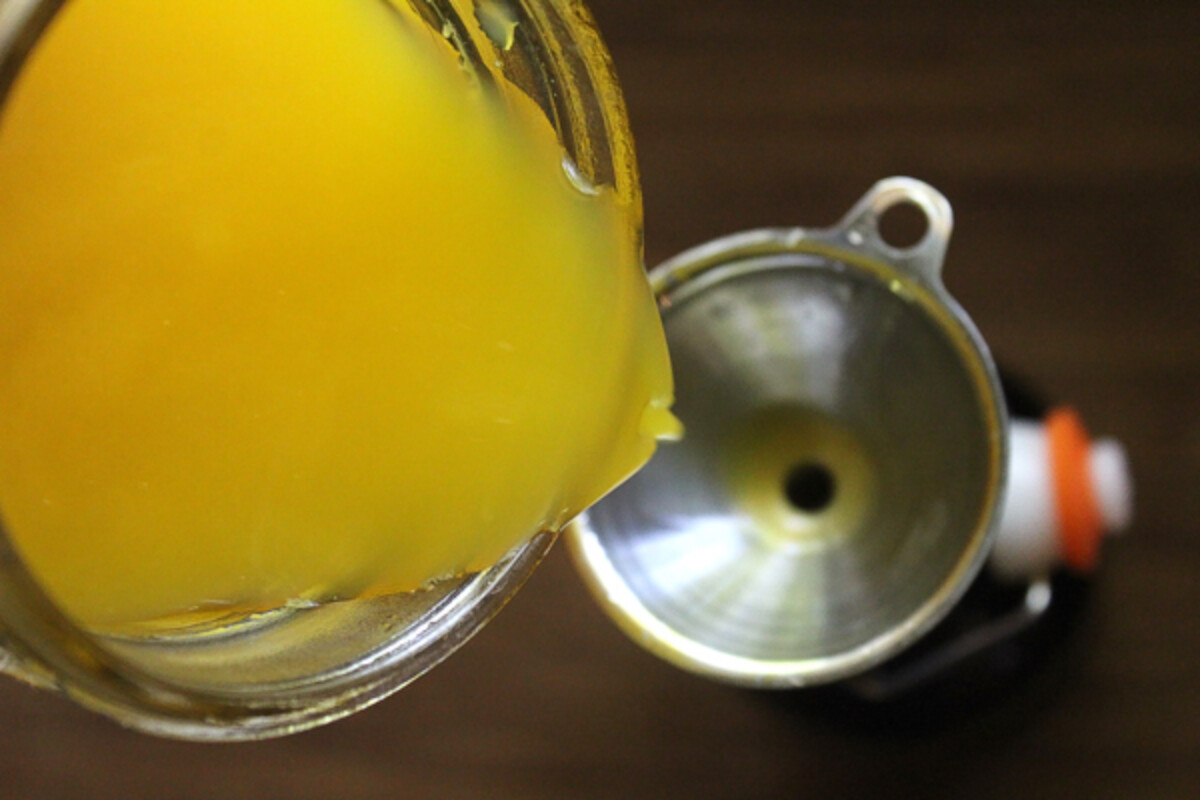
For one gallon batches or bigger, be sure to use a racking cane to pour off the wine so that the sediment stays in the bottom, and bottle in regular wine bottles with corks. It’s not practical to pour off large batches without the help of a siphon.
The recipe below is for a 1-quart batch. Feel free to make it in a standard 1-gallon brewing carboy by multiplying all the quantities by 4. For a 5 gallon batch, multiply by 20.
How does this simplified recipe taste? Spectacular!
The end result is thick and rich, much like the juice that went in at the beginning. Without the pectinase, this wine did not clear at all. It still retains the character of the original juice, and it tastes a bit like drinking a mixture of champagne and mango juice, like I’ve made a mango mimosa.
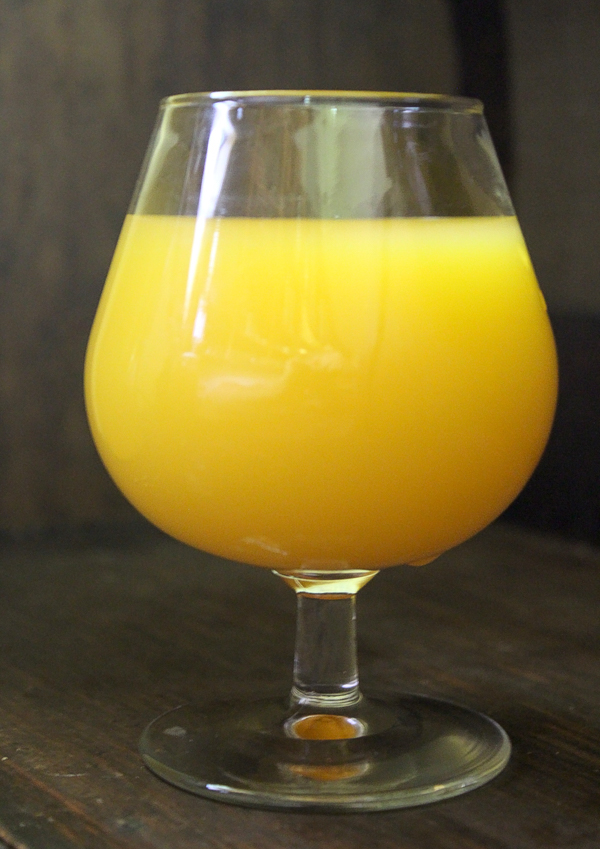
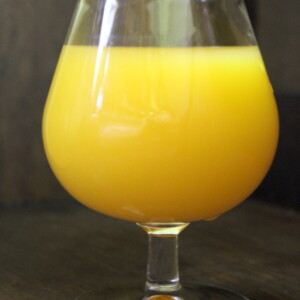
Mango Wine Recipe
Ingredients
- 3 3/4 cups mango juice, or 1 pound mango chunks & water
- 1/2 cup sugar
- 1/4 wine yeast, reserving the rest for other batches
- 1/2 tsp acid blend, (or 1 Tbls. Lemon Juice)
- 1/4 tsp yeast nutrient, (or 3-4 raisins)
- 1/8 tsp Pectic Enzyme, pectic enzyme, (optional unless you’re using fresh mango)
- 1 pinch Tannin Powder, (or grape/currant leaves or 2 Tbls. Prepared black tea)
Instructions
- Fill a quart mason jar with all the ingredients listed above, except the wine yeast. Cap it and give it a good shake to incorporate all the ingredients and help dissolve the sugar.
- Dissolve the wine yeast in a few tablespoons of water and allow it to activate for at least 5 minutes. Pour it into the prepared mango juice.
- Seal the jar with a mason jar fermentation kit.
- Allow the mango wine to ferment for 4 to 6 weeks at room temperature. It’ll take longer in cool weather, but watch for when fermentation has pretty much stopped and bubbles are no longer moving through the water lock for 5+ minutes at a time.
- Slowly pour off the mango wine into another jar, leaving behind any sediment.
- Bottle in the tiny batch in simple Grolsch flip cap bottles and allow it to age for at least 2 weeks, preferably longer.
Nutrition
Nutrition information is automatically calculated, so should only be used as an approximation.
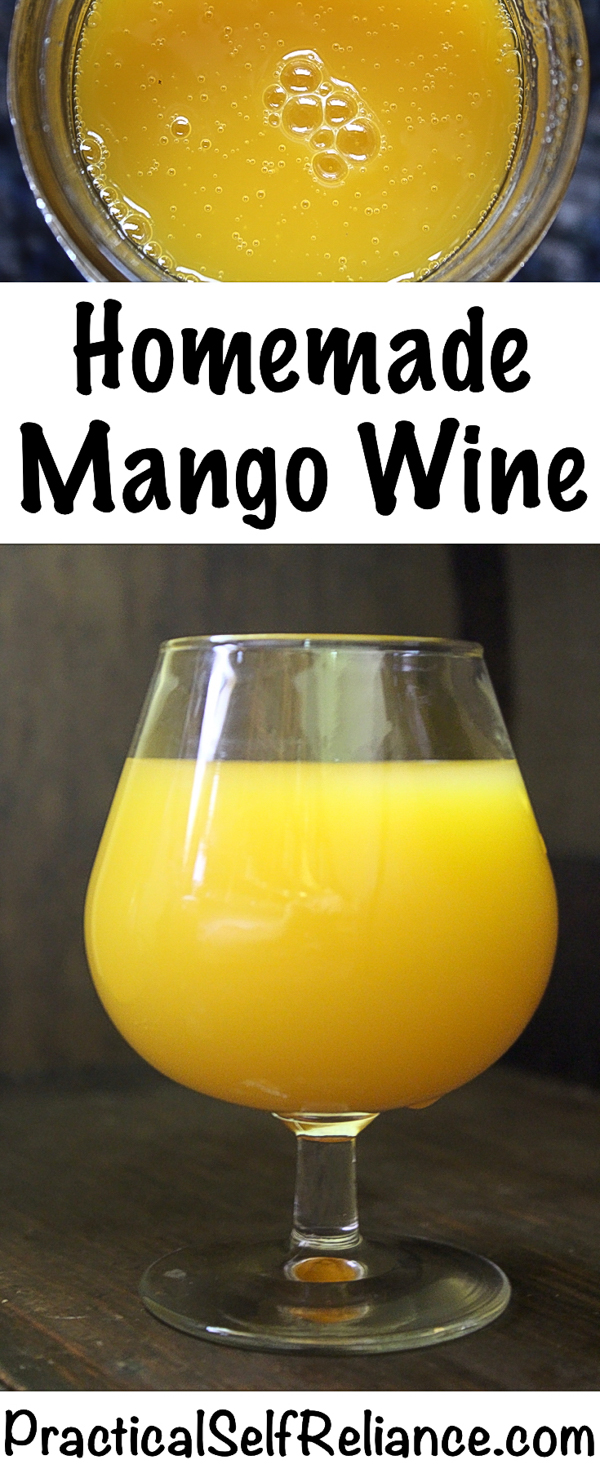


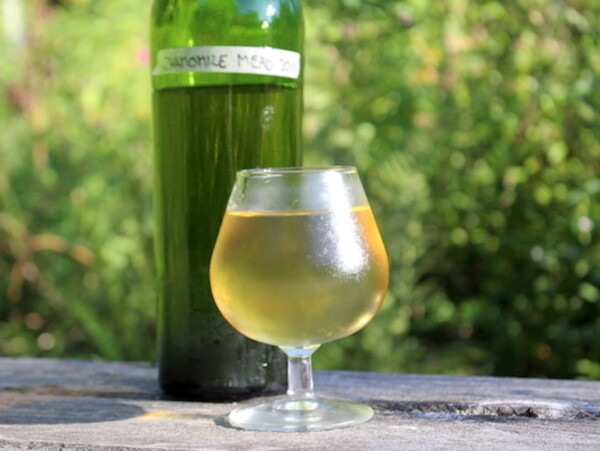
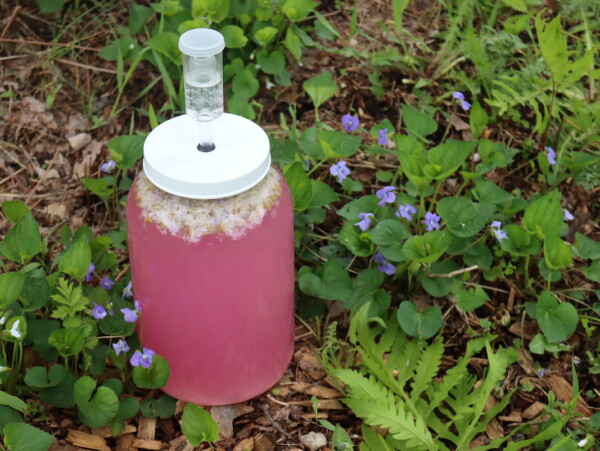










Do I need to do a primary and a secondary stage before bottling it to finish?
It’s actually still fermenting once it goes into the bottle for the 2 week minimum aging process.
This is a great tutorial. I first tried making wine from 1 liter of store-bought mango juice (tetra pack) with only citric acid and sodium citrate as the additives listed in the ingredients. It does mention on the container that it’s 16% mango and 14% pear juice.
First I bought 1.5 liters of bottled spring water since it would be sterile as a primary fermentation container. I poured out the spring water and added the 1 liter of mango-pear juice. Then I added 120-140 grams of sugar, closed the bottle and shook it vigorously for 3 minutes. After that, I pitched some Fermipan instant yeast because wine yeast isn’t available in my country. The room temperature was about 80-82F/27-28C.
I did not use an air-lock but instead fitted a surgical mask over the top of the spring water bottle with the blue side facing down since it was smooth and didn’t have any fibers which could get into the juice and cut off the strings of the surgical mask, using them to tighten it around the opening of the bottle. I figured that would help keep out bacteria and wild yeasts but still allow it to breathe. I also added a bowl filled with some water to place under the bottle as a moat to keep away ants, etc.
Well, that yeast really took off in only a few hours and after 7 days it was smelling great and bubbling seemed to have stopped for the most part along with lots of sediment at the bottom so it was time for a taste test. Wow, that was dry and strong. I must emphasize strong as in high alcohol content despite using Fermipan instant yeast. I had removed the surgical mask and put the original bottle cap back on and then into the refrigerator for a day or two which slowed down the yeast and helped it to settle at the bottom. After that I poured it carefully and steadily into my glass. It tasted pretty good and although I wasn’t looking for a “buzz”, I sure got one! Anyway, I think it was good enough and refreshing, even after 7 days.
I had to open the bottle cap a few times a day to let out carbon dioxide. I’m not sure if a plastic bottle could explode but I didn’t want to take chances.
Sorry for the long-winded post but I’m happy to see you’ve made wine-making easy to do at home and easy for others to understand. I’m also glad you enjoy it despite it not being clear. Who says a good wine must be clear anyway, right? Thanks again. Because of your post I am now making another batch of mango wine.
You’re very welcome and thanks for sharing. We’re so glad you liked the wine and the post.
Do you think the self burping ferment lids would work for this as well?
Yes, most any mason jar fermenting lids work really well. I particularly like the silicone pickle pipes from mason tops.
So, I’m trying to make mango vinegar actually by starting with a mango wine first. I had a blow out on my first batch and I don’t know why. I’m using 2lbs of frozen organic mango that I purée first and adding half a small packet of wine years. Sanitizing everything first and adding the air lock with a little vodka water to prevent any bacteria from getting in. I’m not sure why it blew out on me with mango all over my counter lol. Maybe less yeast? Less mango? Filter out pulp beforehand? I am using distilled water as well. Help!
So, I’m trying to make mango vinegar actually by starting with a mango wine first. I had a blow out on my first batch and I don’t know why. I’m using 2lbs of frozen organic mango that I purée first and adding half a small packet of wine years. Sanitizing everything first and adding the air lock with a little vodka water to prevent any bacteria from getting in. I’m not sure why it blew out on me with mango all over my counter lol. Maybe less yeast? Less mango? Filter out pulp beforehand? I am using distilled water as well. Help!
If you’re using mango puree, it’s probably clogging the airlock. If the frozen mango is in chunks, you can simply add water to the chunks or if you want to use the puree, you will need to strain it to remove the pulp and just use straight juice.
Could this be made using frozen mango chunks?
Yup, that should work fine.
When you pour off the wine, leaving sediment behind, into another jar/bottle and allow to age another two weeks, where is it stored at this time? In the fridge? On the counter? Not sure where I should store the jars of wine at this time…
You want to store it at room temperature. It is still fermenting at this point.
How long does it keep after bottling ? Does it need to to be stored in the fridge ?
It is recommended to keep it in a fridge or cellar. I have seen that it can last up to 3 years if kept in the fridge.
Had a question regarding sanitation. When racking the wine, using star-san, there were quite a bit of bubbles and foam left, which after siphoning into the carboy, was left sitting on top. I’ve read quite a bit and the whole “dont fear the foam” thing is thrown around a lot. Something about it breaking down to then feed the yeasties afterwrds. What are your thoughts? and if some water is needed to fill some of the headspace for the second fermentation, am i ok to use Brita filtered water or would distilled water be a must? Also, i got interested in home brewing purely by stumbling onto one of your articles so wanted to say thanks for that!
Awesome, glad you’re giving it a try. I’m not as intense about sanitation as some brewers, mainly because I know people were doing this in hollowed out logs millennia ago…the results are less consistent that way since wild yeasts add their own flavors, but it does still make tasty wine 99% of the time. Anyhow, I use one-step cleanser and I’ve actually never used Star-san myself, so I can’t really advise you on how that one works.
For secondary, filtered water (without chlorine) is totally fine.
Hope it turns out wonderfully for you!
I forgot to add my raisins and lemon juice. Made the batch three days ago. Can I still add it or is it too late? And will it hurt if that is not added?
You can still add it, no problem. It will still ferment without that, but less efficiently. The acid adjusts the pH to help the yeast function better (and make it taste better in the end) and the raisins feed the yeast. They will still ferment the mixture without those additions, but I’d really suggest adding them (even late) in the process.
Thanks, I am from VT as well. I could not find any recipes without the pectic enzyme, and I am looking to be as organic/self reliant as possible. But the division of labor into specializations allows me to buy the prepared juice in relatively small quantities without too much effort. I think I will try to find a juice in a store next time.
in my past, limited, wine making experience, there was always a step to sanitize the fruit mixture, say keep it at 160F for 15 minutes or so. there is no such step in your recipe. why not, and could not having it result in soilage or even worst a wine that would make you sick?
Another Vermonter here. Thanks for the guide.
Thank you for your time and more power to your business Mam.
Thank you for your time and more power to your business Mam.
Please let me join in your home made recipies
Hello Im Merlo Ferrer ,54 yrs of age from the provjnce of Pangasinan,Philippines.Looking forwaard tp process that mango wine.I am making dried mango,green mango candy,and mango venigar to name a few..Mangpes are abundant in my provinnce so i decided to research here in the internet .Create and innovate for this kind of fruit.Very good qualities of mangoes here is exported to some nations so I can only process the rejected ones.At a cheaper price.I decided to process the green mango candy.Now its already in the market.As a beginner ,i am still making my production area ready for an FDA compliance .
I am interested to know more from you about this wine process.I am making the vinegar in just a simple way by adding yeast from the waste from mango and pinepples.